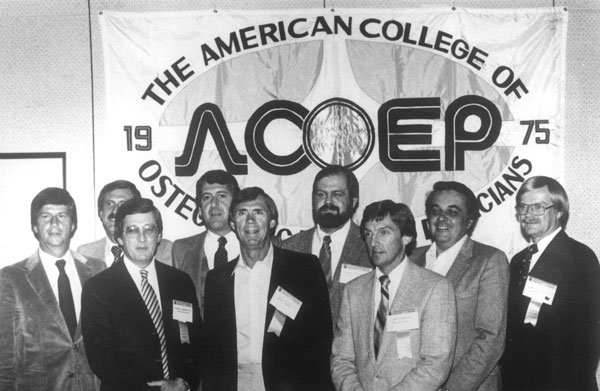ACOEP: A Look Back

On October 5th, 1975, a small, intrepid group of physicians met in Toledo, Ohio. Here, they discussed the growing necessity for a specialty college to support the needs and education of emergency physicians, and the American College of Osteopathic Emergency Physicians was born. From this meeting came a letter of intent, petitioning the American Osteopathic Association to form a specialty college, and the request was granted, giving ACOEP affiliate status.
As time passed, ACOEP grew in size and influence, and became instrumental in firmly establishing emergency medicine’s place as a medical specialty. ACOEP’s board and members worked tirelessly, creating osteopathic emergency medicine residency programs throughout the country; providing CME opportunities for physicians everywhere; presenting top-tier educational events including the Intense Review, Spring Seminar, Scientific Assembly and Oral Board Review.
ACOEP has become an advocate for physicians as well as patients, has provided research, competition, and funding opportunities for students and residents, and continues to ensure that quality training standards are met. The staff has expanded from one administrator, to a team of professionals all working to bring excellent member benefits, advocacy, education, and publications to ACOEP’s more than 3,000 members.
A Timeline of ACOEP
1975: ACOEP is recognized as an affiliate by the AOA and elects its first Board of Directors which consisted of Bruce D. Horton, D.O., President; Anthony Gerbasi, D.O., Vice President; Richard Ballinger, D.O., Secretary; and Robert L. Hambrick, D.O., Treasurer.
1978: The AOA officially issues ACOEP’s charter.
1978: ACOEP hosts its first Scientific Assembly as part of AOA’s Convention. Later that same year, the AOA approved the first Residency Standards for Training in Emergency Medicine.
1979: Gerald E. Reynolds establishes the first osteopathic emergency medicine program at PCOM.
1981: The first written board exam is administered by AOBEM, the oral exam following one year later.
1982: The ACOEP Board of Directors increases from 10 to 12 members and later awards prizes for the first Residency Paper Competition.
1984: The first Fellowship Ceremony takes place honoring Charter Fellows Robert D. Aranosian, D.O.; Richard B. Ballinger, D.O.; John W. Becher, Jr., D.O.; James A. Budzak, D.O.; Donald D. Cucchi, D.O.; Anthony E. Gerbasi, D.O.; James F. Grate, D.O.; Robert L. Hambrick, D.O.; Bruce D. Horton, D.O.; and Edward J. Sarama, D.O.
1986: The ACOEP Newsletter, which will later become The Pulse, becomes ACOEP’s first official publication, with David Brown, DO, serving as editor, as residency programs increase to training more than 100 physicians annually.
1989: Paula Willoughby, DO becomes the first president of the ACOEP Resident Chapter.
1990: Residency programs move from a two-year program to a three-year post-internship program.
1992: ACOEP hires Janice Wachtler as its first full-time administrator. Later, Cary Schnieder, DO, becomes the first president of the ACOEP Resident Chapter.
1994: Anthony Gerbasi, DO, FACOEP becomes the first ACOEP Life Member, as the first CPC Competition takes place as well as the first Intense Review held in conjunction with the Spring Seminar.
1995: ACOEP holds its first Oral Board Review Course.
1996: ACOEP establishes its first video series for 10 hours of CME credit.
1997: ACOEP hits the 1,000 member mark and swears in the first Honorary Member, John Sevastos, D.O.
1998: The Foundation for Osteopathic Emergency Medicine is established as the philanthropic arm of ACOEP.
2008: ACOEP’s Scientific Assembly breaks away from the AOA’s convention and becomes a stand-alone event in Las Vegas.
